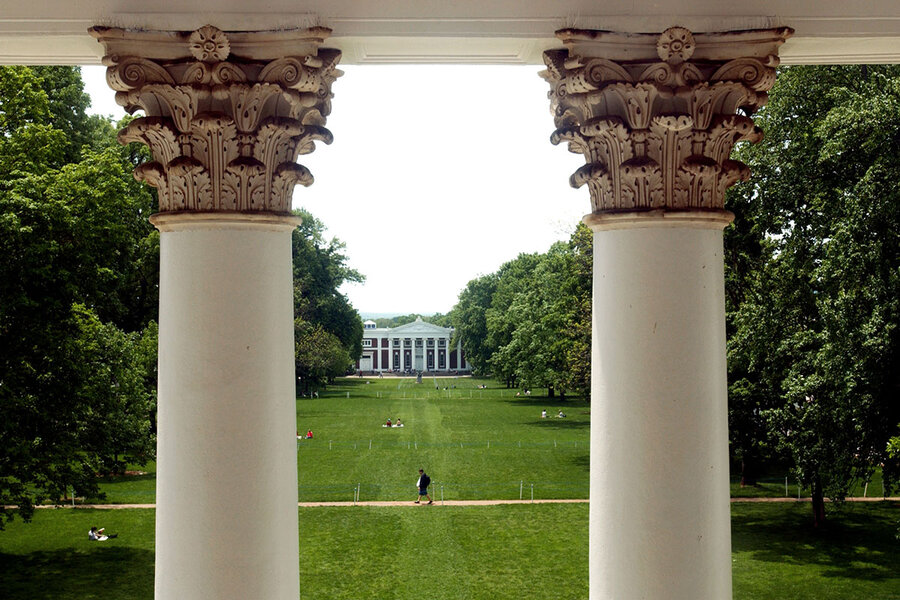Charlottesville, through a graduate's eyes
My school bought its first slave in 1819 for $125.
Until this week, I never knew that my alma mater, the University of Virginia, owned slaves. We were told that slaves built the school, that our founder Thomas Jefferson owned slaves, and that faculty and students brought some of their own slaves to Charlottesville with them. But I didn’t know that my school outright owned them.
The Rotunda – where I began my admissions tour as a high school senior six years ago – flew the first public Confederate flag. Students, my fellow alumni, raised the flag in the middle of the night in 1861. Shortly after, 92 percent of the student body left the Academic Village to fight in the Confederate army.
As I saw the events unfold in Charlottesville this weekend, my first instinct was to renounce my school of any culpability. “That’s a ‘Charlottesville thing,’ not UVa,” I heard myself say.
I know a school that looks too idyllic to be real, with white pillars under the shadow of the Blue Ridge. I know a school with smart people, who debate political theory and hike Humpback Rock on the weekends. I know a school that paints supportive messages on Beta Bridge, has an honor system, and hates hate. I know a school that students are proud of.
But now I realize that my first reaction was illogical. A “Charlottesville thing” is a “UVa thing.” Mr. Jefferson, the author of the Declaration of Independence, picked Charlottesville to house his university, on what was then James Monroe’s farmland. Slaves were rented from nearby farmers to build the Rotunda: the symbolic school logo, the American Parthenon, the realization of Jefferson’s love for architecture and literature.
Over the past two centuries, it has become almost impossible to separate Charlottesville’s present problems from UVa’s immoral past. The city and the school are like two intertwining trees, shaping around one another’s branches with age.
During my time at UVa, researchers found a cemetery of 67 former university slaves next to my first-year dorm, for example.
In 2015, a third-year student Martese Johnson, who is black, was pinned to the ground by three white Alcoholic Beverage Control agents outside of Trinity Irish Pub, a student-favorite. Mr. Johnson was okay, but he has scars on his forehead from the arrest.
During the 2016 election, UVa experienced a series of hate crimes, with anti-gay, anti-Muslim, and anti-Semitic slurs written on doors and buildings. And it recently came to light that Richard Spencer, self-proclaimed leader of the white nationalist movement and creator of the term “alt-right,” graduated from UVa with an English literature degree in 2001.
After this weekend, the events of the last six years started playing on a loop in my head. But it was the incident with Mr. Johnson that I’ve found myself thinking about the most. Maybe it’s because I saw the blood-stained sidewalk on my walk to class the next morning. Or maybe it’s because Johnson was good friends with some of my friends.
However, I think it’s what Johnson yelled when he was being pinned to the ground by officers that has really stuck with me: “I go to UVa! I go to UVa!... How did this happen?”
That’s what I keep thinking when I see the images of tiki torches and tear gas in Emancipation Park. Charlottesville keeps finding itself at the center of racial conflict, but I never met anyone during my four years at UVa who I would consider a racist.
Maybe that’s the problem. Like the hashtag #HoosAgainstHate that flooded Instagram this weekend, we keep saying what Wahoos are not: hateful, discriminatory, racist.
But we also need to be honest about all of the things that we are. Almost all of my professors looked like my parents or grandparents. Until recently we had had a monument for Thomas Jefferson but no plans to honor the 5,000 slaves who laid the school’s bricks. We are a public school where less than 7 percent of students identify as African-American. We owned slaves.
And as difficult as it is to accept ownership of historic racism, it can be even more challenging to confront existing bias.
After his violent encounter in 2015, Johnson wrote, “These officers would probably never admit to being racist, and it is because they truly believe that they are not. The officers did not see a University of Virginia student out with his peers; they saw a young black male with a high-top fade, a gold chain, some tennis shoes, and a hoodie. In their minds, I could not possibly have been a member of the ‘community’ that they had sworn to protect.”
Two years later, Charlottesville is in headlines around the world next to words like “alt-right,” “white supremacy,” and “KKK.”
And when family and friends apologize to me for UVa, the place I love, I can only respond like Johnson.
“I went to UVa! How did this happen?”







